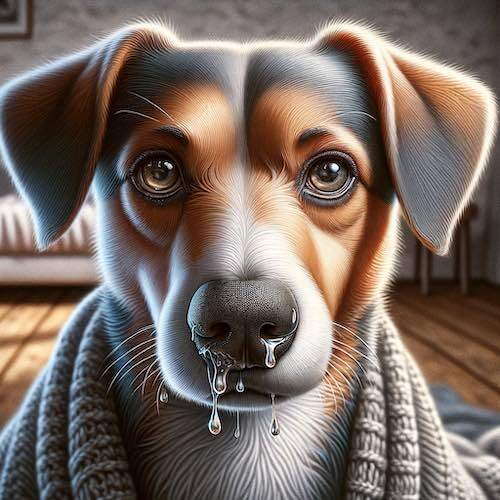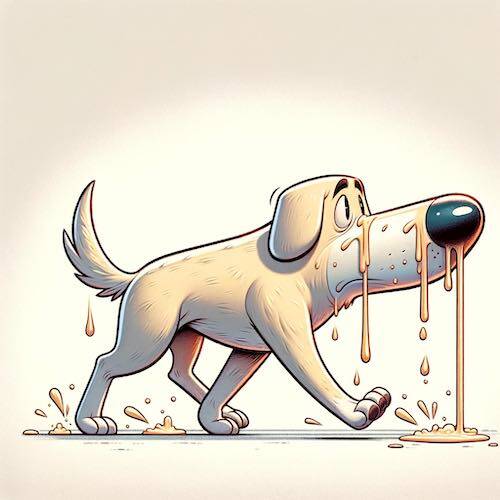Dog Runny Nose: Causes, Symptoms, and Treatments
Introduction
The occurrence of a runny nose in dogs is a common concern for many pet owners, signaling potential health problems that could vary widely in severity. Just as humans experience a runny nose due to various reasons, dogs too can show similar symptoms for a multitude of underlying causes. These can range from the relatively benign, such as exposure to cold weather or allergens, to more severe issues including infections or even nasal blockages.
Search: Best Selling Dog Runny Nose Relief
It’s imperative for dog owners to not only recognize these symptoms but also understand the underlying causes and the most effective ways to address them. This article aims to provide a comprehensive overview of the reasons behind a dog’s runny nose, accompanied by symptom identification and an exploration of treatment options. By equipping pet owners with this knowledge, we strive to empower them to take prompt and appropriate action, ensuring the health and happiness of their canine companions through informed care and preventive measures.
Causes of a Dog Runny Nose
Allergies
- Description: Similar to humans, dogs can suffer from allergies caused by dust, pollen, mold, and certain foods.
- How it leads to a runny nose: Allergens can irritate the nasal passages, leading to increased mucus production.
Dogs, like humans, can be sensitive to a variety of environmental allergens including dust mites, pollen, mold spores, and even specific ingredients in their food. These allergens can trigger an immune response in susceptible dogs, leading to inflammation of the nasal passages. As the body attempts to combat these allergens, it produces excess mucus as a protective mechanism, resulting in a runny nose. This response is the body’s way of trying to flush out the irritants. Managing a dog’s exposure to known allergens and consulting with a veterinarian for appropriate allergy treatments can help alleviate these symptoms.
Infections
- Viral: Conditions like canine distemper and influenza.
- Bacterial: Bacterial infections can occur on their own or secondary to a viral infection.
- How infections lead to a runny nose: Infections inflame the nasal passages, causing a discharge.
Canine nasal infections, whether viral or bacterial, are significant causes of nasal discharge. Viral infections like canine distemper and influenza compromise the dog’s respiratory health, while bacterial infections may take hold either as a primary issue or following a viral infection, exacerbating the problem. These infections lead to inflammation and swelling of the nasal tissues, disrupting normal mucus flow and resulting in a noticeable discharge. Prompt veterinary diagnosis and treatment are crucial in managing these infections, as they can lead to more severe health issues if left untreated.
Foreign Bodies
- Description: Small objects can become lodged in a dog’s nasal passages.
- How it leads to a runny nose: The body’s response to a foreign object is to increase mucus production to expel the object.
When small objects such as seeds, tiny stones, or pieces of toys become lodged in a dog’s nasal passages, they can cause considerable discomfort and irritation. The dog’s natural response to a foreign body is to produce more mucus in an effort to encapsulate and expel the object. This increased mucus production can lead to a runny nose, often accompanied by sneezing or pawing at the face. Veterinary intervention may be required to remove the object safely and alleviate the dog’s discomfort.
Nasal Tumors
- Description: Although less common, tumors in the nasal passages can occur.
- How they lead to a runny nose: Tumors can block normal airflow and mucus drainage, leading to discharge.
Though less frequent, nasal tumors can be a serious cause of nasal discharge in dogs. These growths can obstruct the nasal passages, hindering normal airflow and drainage of mucus, which leads to accumulation and discharge. Symptoms may include chronic nasal discharge, nosebleeds, or even facial deformity in advanced cases. Early detection and treatment are vital for managing this condition, highlighting the importance of regular veterinary check-ups, especially in older dogs who are more prone to tumors.
Dental Issues
- Description: Dental abscesses or infections can affect the nasal passages due to their close proximity.
- How it leads to a runny nose: Infection from the teeth can spread to the nasal passages.
Dental health plays a crucial role in overall canine well-being, with dental issues such as abscesses or infections having the potential to affect the nasal passages. The close proximity of the dog’s teeth to its nasal passages means that infection can easily spread, leading to nasal discharge as a secondary symptom. This is why dental infections require prompt veterinary care, not only to address the dental disease itself but also to prevent complications like a runny nose or even more severe sinus infections. Regular dental check-ups and hygiene can prevent such issues from developing.
Symptoms Accompanying a Runny Nose in Dogs
- Clear Discharge: Often a sign of allergies or minor irritation.
A clear discharge from a dog’s nose is usually the first sign of either environmental allergies or minor nasal irritation. This kind of discharge is typically watery and not accompanied by other significant symptoms, suggesting a less severe reaction or condition. However, continuous clear discharge can lead to dehydration or may signify that the dog is constantly exposed to the allergen or irritant. Observing the frequency and conditions under which the clear discharge occurs can provide valuable clues to the underlying cause, aiding in effective management and treatment strategies.
- Purulent (Pus-like) or Bloody Discharge: May indicate a more serious infection or the presence of a tumor.
A nasal discharge that is purulent (resembling pus) or mixed with blood often points towards a more serious condition, such as a deep-seated bacterial infection, nasal tumors, or even a fungal infection. This type of discharge indicates that the body is actively fighting off a significant infection or reacting to a tumor’s presence. Accompanying symptoms may include a foul smell, noticeable facial swelling, or a reduction in appetite, reflecting the severity of the underlying condition. Immediate veterinary attention is crucial to diagnose and treat the root cause effectively.
- Sneezing and Coughing: Can occur if the cause of the runny nose is respiratory in nature.
Sneezing and coughing in conjunction with a runny nose are strong indicators of a respiratory issue. These symptoms can arise from common colds, influenza, or more serious conditions like bronchitis or pneumonia. The act of sneezing serves to expel irritants from the nasal passages, while coughing clears the lower respiratory tract. Persistent sneezing and coughing not only cause discomfort but can also lead to further complications, such as secondary infections or exacerbation of the original condition.
- Difficulty Breathing: May occur in severe cases or if foreign bodies are present.
Difficulty breathing in dogs, especially when coupled with a runny nose, is a symptom that warrants immediate veterinary attention. This can occur in severe allergic reactions, the presence of large foreign bodies obstructing the nasal passages, or advanced tumors. Labored breathing may manifest as increased effort to inhale or exhale, noisy breathing sounds, or even a complete inability to breathe through the nose. This distressing symptom significantly impacts the dog’s quality of life and may quickly become life-threatening.
- Pawing at the Nose: Indicates discomfort or an attempt to dislodge a foreign object.
When a dog persistently paws at its nose, it’s a clear sign of discomfort or irritation in the nasal area. This behavior is an attempt to relieve the discomfort caused by foreign bodies, such as grass seeds or small objects, that may have become lodged in the nasal passages. Additionally, this can also indicate the presence of itchiness or pain associated with infections or allergies. Continuous pawing can lead to self-inflicted injuries or exacerbate the underlying issue, making it important to closely monitor this behavior and seek veterinary care if it persists.
Treatments for a Dog Runny Nose
Addressing Allergies
- Allergen avoidance: Identifying and reducing exposure to allergens.
- Medication: Antihistamines or corticosteroids prescribed by a veterinarian.
Allergen avoidance is the cornerstone of managing allergies in dogs. This strategy involves identifying the specific allergens causing reactions and minimizing the dog’s exposure to them, which may include environmental modifications or dietary changes. Medication plays a crucial role in allergy management, with antihistamines or corticosteroids often prescribed to alleviate symptoms.
These medications help reduce inflammation and the immune system’s overreaction to the allergen. Regular consultations with a veterinarian are essential to adjust the treatment plan as needed, ensuring the dog’s comfort and reducing the incidence of allergic reactions. Additionally, immunotherapy may be considered for long-term management, offering a more permanent solution by desensitizing the dog’s immune system to the allergens.
Treating Infections
- Antibiotics: For bacterial infections, after a vet’s diagnosis.
- Supportive care: Ensuring hydration and proper nutrition during recovery.
Treating bacterial infections in dogs typically involves a course of antibiotics, prescribed only after a thorough veterinary diagnosis to ensure the appropriate type and dose. Supportive care is equally important during the recovery process, with a focus on maintaining hydration and ensuring the dog receives proper nutrition to support its immune system. In some cases, nebulization or steam therapy may be recommended to help clear the nasal passages and alleviate congestion. Monitoring the dog’s response to treatment and making any necessary adjustments is key to a successful recovery, with follow-up visits to the vet to ensure the infection has been fully resolved.
Removing Foreign Bodies
- Veterinary intervention: Removal under sedation or anesthesia by a professional.
Veterinary intervention is necessary for the safe removal of foreign bodies from a dog’s nasal passages. This procedure typically requires sedation or anesthesia to ensure the dog’s comfort and safety during the removal process. Advanced imaging techniques, such as endoscopy, may be employed to locate and retrieve the object with minimal discomfort. Post-procedure care is important to ensure the nasal passages heal properly and to monitor for any signs of infection or complications. Prompt action in seeking professional help when suspecting a foreign body can prevent further irritation or injury to the dog’s nasal passages.
Managing Dental Issues
- Dental care: Professional cleaning or extraction of affected teeth.
Professional dental care, including cleaning or extraction of affected teeth, is vital in managing dental issues that could lead to a runny nose. Regular dental check-ups and cleanings can prevent the buildup of plaque and tartar, which are common causes of dental abscesses and infections. In cases where dental issues have led to nasal symptoms, treating the root cause is essential to alleviate these symptoms and prevent recurrence. Owners can also support dental health through daily tooth brushing and offering dental chews that promote gum health and reduce plaque.
Treating Nasal Tumors
- Surgical removal: Depending on the location and size of the tumor.
- Radiation therapy: In cases where surgery isn’t feasible.
Surgical removal of nasal tumors may be an option, depending on the tumor’s location, size, and the overall health of the dog. This approach aims to eliminate the tumor and restore normal nasal function. When surgery is not feasible, radiation therapy may be considered as an alternative treatment method. Radiation therapy can target the tumor cells while sparing surrounding healthy tissue, offering a way to manage the tumor and alleviate symptoms. Both treatment options require careful consideration and planning by a veterinary oncologist, with the goal of maximizing the dog’s quality of life while managing the disease.
Price: $17.99 ($35.27 / Fl Oz)
11 used & new available from $17.99 ($35.27 / Fl Oz)
Preventive Measures and Home Care
- Regular veterinary check-ups: Early detection of potential issues.
Scheduling regular veterinary check-ups is crucial for the early detection of potential health issues, including those that could lead to a runny nose. These visits allow for prompt intervention and can prevent minor conditions from escalating into more serious problems. Consistent monitoring of your dog’s health by a professional can also provide peace of mind and guidance on maintaining optimal wellness.
- Dental hygiene: Regular brushing and dental check-ups.
Maintaining dental hygiene through regular brushing and dental check-ups is key to preventing dental issues that could affect your dog’s nasal health. Implementing a routine of daily dental care and professional cleanings can significantly reduce the risk of infections and dental diseases, contributing to your pet’s overall health and comfort.
- Environmental management: Keeping the home clean and free from dust and allergens.
Environmental management involves keeping the home clean and minimizing exposure to dust and allergens, which can trigger nasal symptoms in dogs. Using air purifiers, frequently washing bedding, and avoiding smoking near pets are effective strategies to improve air quality and reduce allergen exposure, supporting a healthier living environment for your dog.
- Humidifiers: Can help keep nasal passages moist, especially in dry environments.
Utilizing humidifiers in the home can help maintain moisture in the air, which is beneficial for keeping your dog’s nasal passages moist, particularly in dry environments or during winter months. This can alleviate discomfort and prevent irritation in the nasal passages, ensuring your dog remains comfortable regardless of the climate.
Conclusion
A runny nose in dogs, while seemingly a minor issue, can indicate underlying health concerns ranging from simple environmental allergies to more complex conditions like infections or nasal obstructions. Recognizing the signs early and seeking veterinary advice is crucial in addressing the root cause effectively and avoiding potential complications. Each cause of a runny nose demands a tailored treatment approach, emphasizing the importance of a precise diagnosis. Veterinary professionals can offer comprehensive care, from conducting thorough examinations to prescribing specific medications or recommending surgical interventions when necessary.
For pet owners, being proactive about their dog’s health is essential. This includes regular monitoring for any signs of distress or illness, maintaining a clean and safe living environment, and adhering to a routine of preventive veterinary care. By taking these steps, owners can play a pivotal role in ensuring their dogs’ well-being, allowing them to lead full, vibrant lives. Understanding the significance of a runny nose and responding promptly can make a significant difference in the outcome, underscoring the value of awareness and timely action in pet healthcare.




